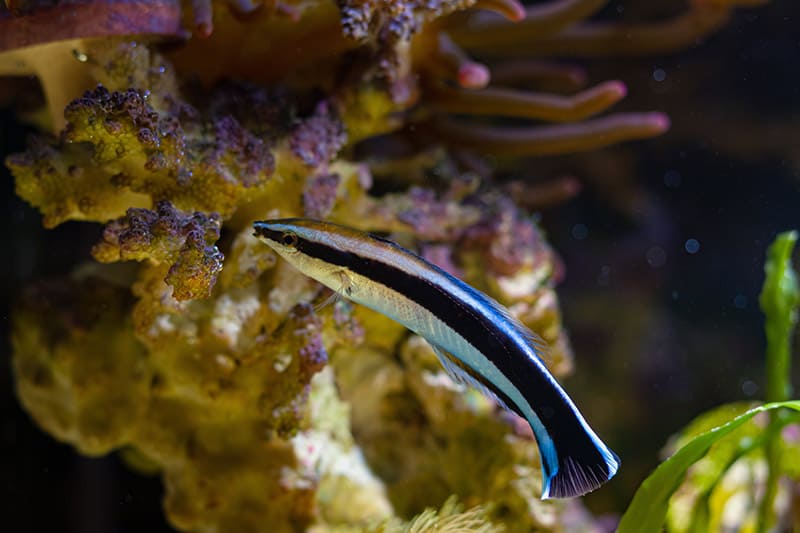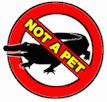The Bluestreak Cleaner Wrasse or Common Cleaner Wrasse is one of the most fascinating and well-known saltwater fish.
When talking about a cleaner wrasse, the Common Cleaner Wrasse or Bluestreak Cleaner Wrasse is the fish that is generally being referred to. Though there are actually five species of Labroides, the Bluestreak Cleaner Wrasse is the best known. It has the widest natural distribution in the tropical Indo-Pacific of these cleaners, it has been the focus of most research studies, and it is the species most commonly seen in fish stores.
The Bluestreak Cleaner Wrasses will form a symbiotic relationship with the other reef fish by cleaning them of unwanted parasites. Cleaner Wrasses are peaceful attractive fish with a most intriguing “dance” that they perform to solicit clients (other fish) and to calm them, allowing the cleaners to remove parasites and other debris from their clients bodies, fins, and mouths. They often set up a “cleaning station”, an area where the other fish can visit just for this beneficial service. Often times the fish can be seen inside the mouth of much larger fish cleaning away!
| Dr. Jungle says, “Cleaner Wrasses are no longer recommended for the average marine aquarium.” | Learn More… |
|---|---|
| To Learn about the concerns of keeping Cleaner Wrasses in home marine aquariums, and the effects of removing them from their natural habitats, |
Like all the cleaner wrasses, the Bluestreak Cleaner Wrasse’s sustainability in captivity is dismal, even though it is the best survivor in this group of wrasses. Fortunately there are a variety of other marine species you can choose from that perform beneficial cleaning services for other fish. These other cleaners are readily available and sustainable. The two main groups of cleaner fish are the gobies (genera gobiosoma especially) and wrasses. Some juvenile species of angelfish will also perform cleaning services. Another intriguing alternative is the cleaner shrimps, such as species of the genera Lysmata and genera Periclimenes.
- For information on keeping marine fish see: Guide to a Happy, Healthy Marine Aquarium
Scientific Classification
| Kingdom: | Animalia |
| Phylum: | Chordata |
| Class: | Actinopterygii |
| Order: | Perciformes |
| Family: | Labridae |
| Genus: | Labroides |
| Species: | dimidiatus |
Bluestreak Cleaner Wrasse – Quick Aquarium Care
| Aquarist Experience Level: | Advanced |
| Aquarium Hardiness: | Difficult to Impossible |
| Minimum Tank Size: | 20 gal (76 L) |
| Size of fish – inches: | 5.5 inches (13.97 cm) |
| Temperament: | Peaceful |
| Temperature: | 74.0 to 79.0° F (23.3 to 26.1° C) |
- My Aquarium – Enter your aquarium to see if this fish is compatible!
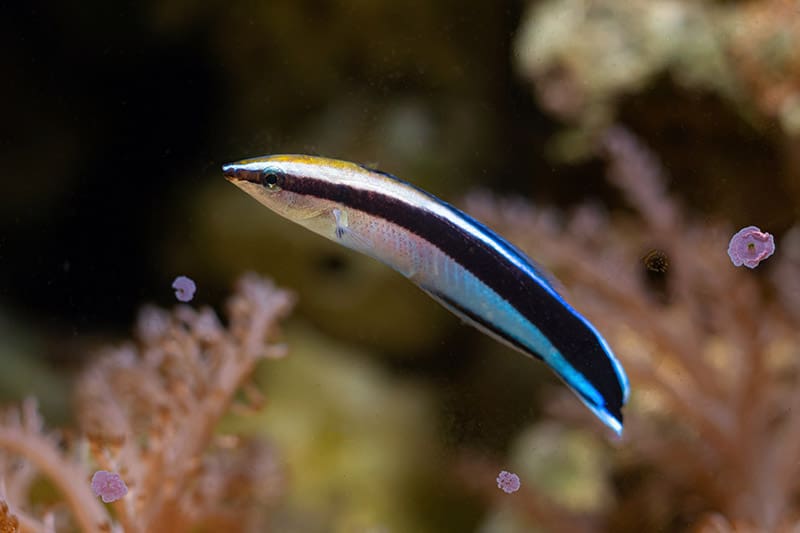
Habitat: Distribution / Background
The Common Cleaner Wrasse or Bluestreak Cleaner Wrasse is found in the Indo-Pacific from the Red Sea to the Line, the Marquesas, and Ducie Islands, Japan, and Lord Hoe and Rapa Islands. They are found at depths of 1 to 30 meters (3.28 to – 98 feet). It inhabits all reef areas of inner lagoons, reef terraces, and outer reefs.
- Scientific Name: Labroides dimidiatus
- IUCN Red List: NE – Not Evaluated or not listed – These fish are not listed on the IUCN Red List.
Description
The Bluestreak Cleaner Wrasse or Common Cleaner Wrasse is a small fish with a slender elongated body. The body is separated by a large black horizontal band with white on the underside and generally blue on the upper half, though fish from deeper water will often have a yellow back.
- Size of fish – inches: 5.5 inches (13.97 cm) – Bluestreak Cleaner Wrasse adults reach up to about 5.5 inches (14 cm).
Fish Keeping Difficulty
Very difficult. Though reef safe and peaceful the Bluestreak Cleaner Wrasse is only for advanced to expert aquarists. Out of all the Labroides this cleaner has the best survivability record, still many will last only a couple of weeks to a month before dying from malnutrition even if they are feeding on prepared foods.
Unlike ‘facultative‘ cleaners such as cleaner gobies and cleaner shrimp, cleaner wrasses are ‘obligate’ feeders. Facultative cleaners engage in removing parasites from other fish but this in not their primary diet. For ‘obligate’ cleaners such as these wrasses, the cleaning activity provides them with their primary source of food. Most of the Labroides will accept prepared foods, but still starve due to malnutrition.
- Aquarium Hardiness: Difficult to Impossible
- Aquarist Experience Level: Advanced
Foods and Feeding
The Bluestreak Cleaner Wrasses are carnivorous. Just as their name describes, they are cleaner fish whose entire lifestyle consists of (and relies on) a symbiotic relationship with other fish.They are classified as obligatory feeders, meaning they obtain all or virtually all of their nutrition by consuming parasites dead tissues, mucus, and other debris from the bodies, fins, and mouths of other fish.
Ideally cleaner wrasses could be kept in a reef environment supporting a large and diverse population of fish along with a variety of ectoparasites, basically supplying enough natural foods to sustain the cleaners.
In less than an ideal environment, trying foods similar to their natural diet such things as Cyclopeeze or daphnia would be highly recommended. Also encouraging them to take other finely chopped meaty foods such as shrimp, brine shrimp, squid, clams, and even chopped beef heart has said to be successful. In the wild they feed constantly while performing their normal cleaning activities, in the aquarium they should be fed several times a day. Very few have been successfully encouraged to eat other foods.
Even with these efforts survivability is questionable. Most of the time these fish will seem like they are doing fine eating prepared foods, only to slowly die from malnutrition.The Bluestreak Cleaner Wrasse L. dimidiatus is the cleaner most often reported as being kept with any success, and it too is very minimal.
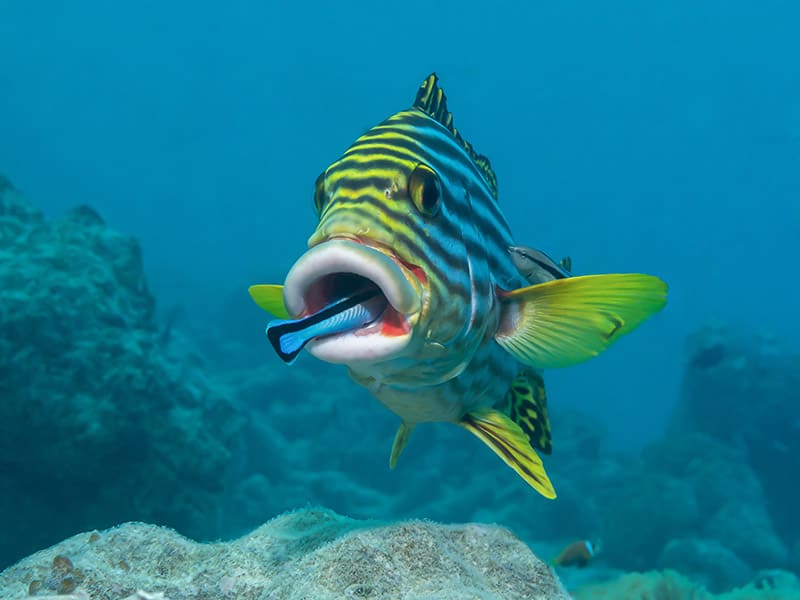
Aquarium Care
The few reports of successfully keeping any cleaner wrasses indicate that they are hardy once acclimated and if kept in quality water conditions. These are cleaners that have survived the stress of importation and relocation, and are eating prepared foods.
They will sleep in holes in the rock or reef, or burrow into the substrate. Basic marine aquarium maintenance includes frequent water changes.
- For more information see, Marine Aquarium Basics: Maintenance
Aquarium Setup
This fish likes to have plenty of live rock for hiding and for stationing their “cleaning posts”, along with a lot of fish to clean. Provide a sandy substrate, though they may sleep in holes in the rock or reef, they often burrow into the substrate at night. They also have a tendency to jump from the aquarium, so keep it tightly covered.
Water Region: Top, Middle, Bottom
They will spend time in all parts of the aquarium. If two of these wrasses are kept together they may establish a cleaning station, while those kept singly will tend not to do this in captivity.
- Minimum Tank Size: 20 gal (76 L) – A minimum 20 gallon (78 liters) aquarium, though 55 gallon (208 liters) is preferable.
- Substrate Type: Any
- Lighting Needs: Moderate – normal lighting – Prefer sunlight, though these fish are diurnal and sleep when it gets dark.
- Temperature: 74.0 to 79.0° F (23.3 to 26.1° C)
- Water Movement: Any
- Water Region: All – They will spend time in all parts of the aquarium. If two of these wrasses are kept together they may establish a cleaning station, while those kept singly will tend not to do this in captivity.
Social Behaviors
The Bluestreak Cleaner Wrasses live singly or in groups. As adults some become solitary and territorial. In the wild a cleaning station will have either a pair of adults, a group of juveniles, or a group of females with one dominant male. They will form pairs in the aquarium but it is hard to tell sexes so several different sized fish should be placed together to avoid problems.
All cleaner wrasses are peaceful and beneficial in keeping other fish parasite free. Labroides have a symbiotic relationship with other fish who provide them with nutrition. In return for their services they are even afforded a certain degree of protection from the natural predatory inclinations of larger fish which instead become their hosts. Some of the Labroides even clean large moray eels! Fish will come to the “cleaning” station on a regular basis to be cleaned.
Research the type of fish this cleaner regularly cleans before adding to the tank to be sure a larger fish doesn’t eat the cleaner wrasse due to not recognizing it. Though most fish recognize cleaners, large morays may not accept all cleaner wrasses! Anglers, Frogfish, and the like may be dangerous companions.
- Temperament: Peaceful
- Compatible with:
- Same species – conspecifics: Yes
- Peaceful fish (gobies, dartfish, assessors, fairy wrasses): Safe
- Semi-Aggressive (anthias, clownfish, dwarf angels): Safe
- Safe
- Large Semi-Aggressive (tangs, large angels, large wrasses): Monitor – For the most part, all tank mates will appreciate cleaning and so will not attempt to eat cleaner wrasses. Notable exceptions include large morays, anglers, and frogfish.
- Large Aggressive, Predatory (lionfish, groupers, soapfish): Monitor
- Safe
- Anemones: Safe
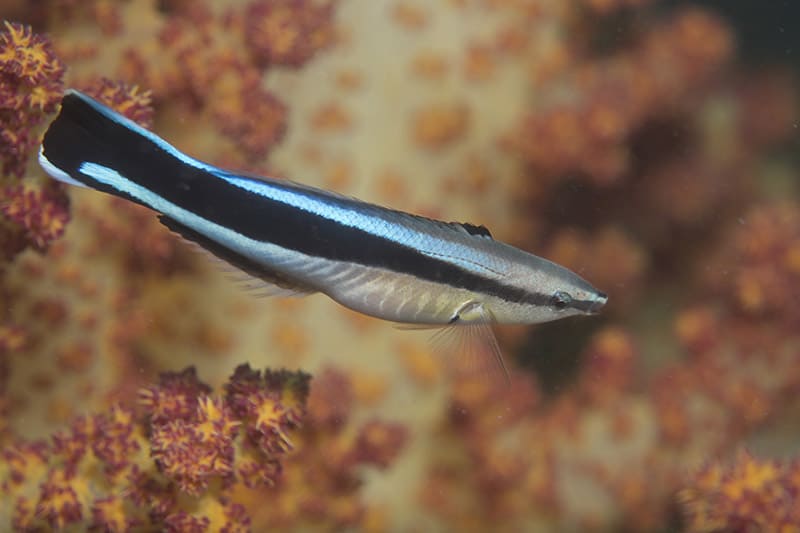
Sexual differences
Unknown, the gender of the Bluestreak Cleaner Wrasse cannot be distinguished visually.
Breeding / Reproduction
Pairs regularly spawn in aquariums, but success is rare. The courtship ritual is especially interesting. The eggs, which are about the same size as the pygmy angelfish (Centropyge) eggs, are released into the water column. This happens once per day during the twilight hours.
Availability
The Common Cleaner Wrasse is often available both in pet stores and on the internet. However due to the extremely low success rate in keeping them alive, they are not recommend for the home marine aquarium. Be sure to carefully consider your impact on this species and on the ornamental fish industry as a whole before purchasing these fish.
- Beginner Fish – Saltwater fish for beginners
- Community Fish – Peaceful Saltwater fish
- Hardy Fish – Hardy Saltwater fish
- Similar size fish – Fish that are 1 inch bigger or smaller
- Coldwater Fish – Looking for cold water fish? (65°)
Featured Image Credit: Aleron Val, Shutterstock
